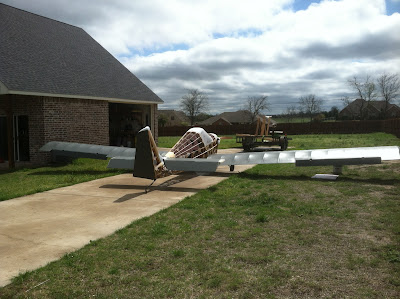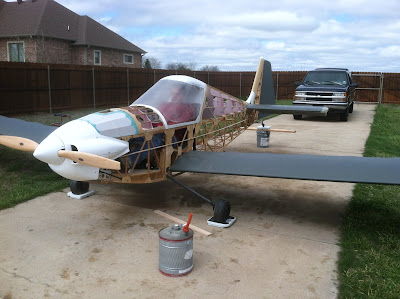Well the weather finally broke, I sat inside working on my new wing redesign until I saw the first glimpse of the sun. I quickly gave my buddy Ed a shout and he came over to help me assemble the Robin out doors for the first time. This will be the longest Blog entry to date, there are a ton of pictures. Most were taken by Ed who showed me all the cool features I never knew the I-phone had!!
 |
| Farmer Ed |
 |
| Front view |
 |
| a man and his plane!!! |
Here I am with my other friend
 |
| Me and Boo |
Me and You and a dog named "Boo"
Left quarter view
I'm pretty sure I will need a larger rudder.
Right Rear Quarter view
looking down the L/H wing. We are getting set up for the weight and balance
Looking down the R/H wing
L/H cowl view
My Friend Yuki Yoshi Ishihara of Chiba Prefecture Japan bought me this Propeller. I plan on Painting the words "Yuki's Prop" on it eventually. This is a CGS ground adjustable prop. It weighs 8.5 lbs. I will switch to a fixed pitch Spruce blade once I dial in the correct pitch. That will reduce my empty weight by 7 lbs.
looking up
Exhaust side
I thought this was a pretty cool Picture Ed took.
 |
| leveling the Robin while Boo supervises |
Ed and I discovered a huge scale error under load. We spend some time calibrating the scales until we were assured they were accurate. That's what I get for buying $7.00 scales from Target!!
 |
| important first step!!! |
Now this was a really important first step, literally!!! I rebuilt the inbd root leading edge of the L/H wing to add a walk way. It was solid as a rock!!
 |
| size 11's |
An old designer once told me never to design for a skinny kid!! They never have any money!!
It is very comfortable in that cockpit. The profile of the seat is right out of a Jantar Ad in Soaring magazine. They claim its the most ergonomic seat shape ever designed. I believe them!!!
notice that the gear still has negative camber at full gross weight!!
 |
| Real Dummy |
See if this Dummy looks just like
 |
| Fake Dummy |
this Dummy!!!
(notice the gut)
 |
| Real Dummy again |
The Jantar seat profile is really clear in this view. The Yarmulke really does its job. I definitely need to add some vents. It got hot really quick in that green house
 |
| Ed playing with his "Stick" |
I asked Ed to work the controls and play with the Stick, I think he misunderstood me!!!!!
 |
| final weight and balance |
So here is the end result of all of this fiddling around. I calculated the Neutral Point (NP) at 37.5% This is the point around which all the aerodynamic forces are balanced. The center of gravity must be forward of the NP with a margin of safety Typically 10% to 15%
Well after all the sweating and sleepless nights here is the final numbers.
CG with no fuel is 29.1% with a static margin of 8.2%
CG with fuel is 25.8% with a static margin of 11.5%
this is a good link to an online calculator http://www.geistware.com/rcmodeling/cg_super_calc.htm
This is as close to perfect as I ever thought I could get. Now for the best news, the plane weighs 262 lbs with the 7 lbs extra weight prop hub. and with parachute it will weigh 276 under the 284 FAA part 103 weight allowance allowed for a Ballistic chute. With the light prop the empty weight will be 255lbs. The new wings will be at least 30 lbs lighter, that and some other weight improvements will easily allow for brakes and a starter on plans built planes.









2 comments:
Can't wait to see this thing fly.
Me too!! I have flown it in flight Sym and in my daydreams
Post a Comment